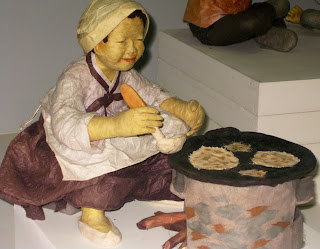According to Wikipaedia, Seoul has over eighty museums and counting! Some of these are National Museums and some Municipal museums but most are are privately owned. I would have to be here for many weeks if I was to see half of these Museums and I love going to Museums ( to my hubby's horror)! Thus I had to get choosey.
I had read that Seoul has a Quilt Museum so that was definitely on top of my list to visit. Being over 60 one gets to pay reduced fees or at many places, the entrance is free! Old age has it's advantages.

This museum is situated at the converted bottom floor of the owners home.
Unfortunately taking photos is not permitted but somehow I managed to get one or two.
"Nubi" is the Korean word for quilt but the curator prefers to use "quilt" as it is universally recognised. This traditonal style of quilting is called Pojagi and the cloth was originally made to wrap gifts and carry religious scripts. The fabric used is called ramie and is quite stiff. Linen or hemp are good modern day substitutes.


The pieces are joined so no raw edges are evident and the quilting was originally done using a gold thread. The quilting consists of three stitches and a space and then three stitches. You may just be able to see these stitches in the photograph I took through the glass case!!
 |
| Sorry about the lousy photo but it was not supposed to be taken. My camera just went off. |
 |
| This photo is not taken in the museum. |
It means to think over something well, be patient and make a decision after three years!!
 |
| Nor this one but it gives a good idea. |

On Jeju Island I set off on a rainy afternoon for the Paper Doll Museum. Taking photographs was permitted and the display was outstanding.
This museum is situated under the World Cup Stadium of 2002!! Ingenius I would say! No dead space in Seoul.
This work is known as Hanji and the paper is made from the Dak tree or Mulberry tree as we know it.


I was absolutely thrilled by the display and my little camera worked over time. Brilliant work.


The village scenes are colourful and full of action. It takes a Hanji worker three years of study and then each figure can take up to three months to create.
 |
| Granny is giving the boy a good wash? |
 |
| These two are day dreaming! |
The next blog will be my exciting visit to The Teddy Bear Museum.


